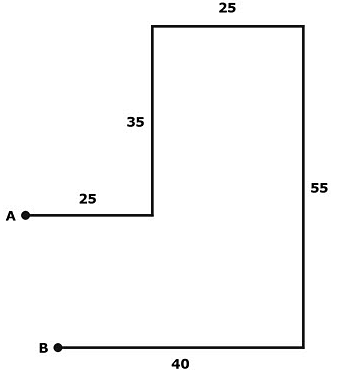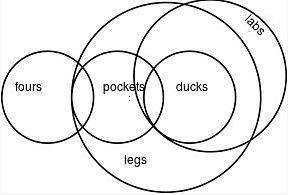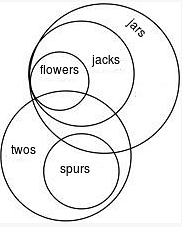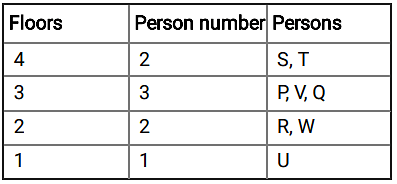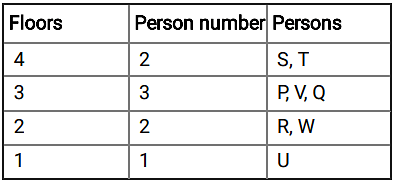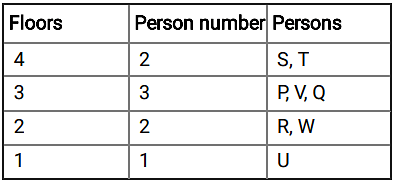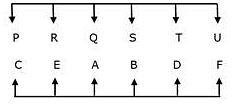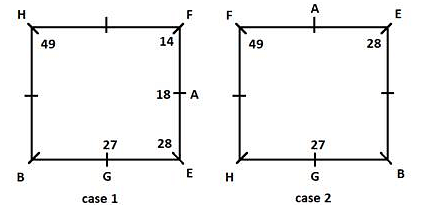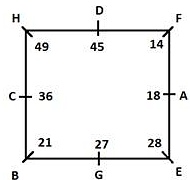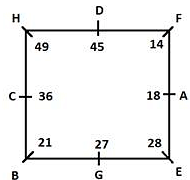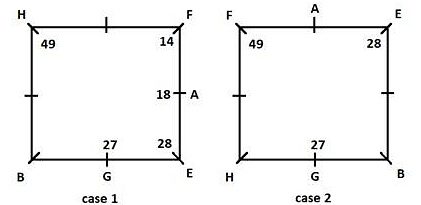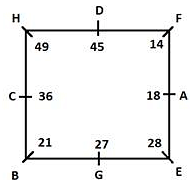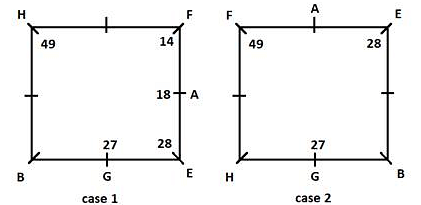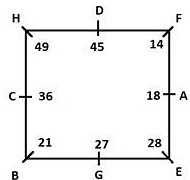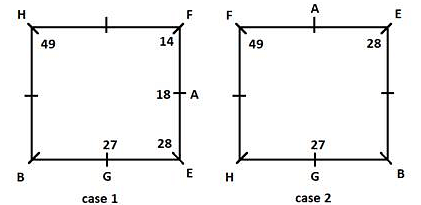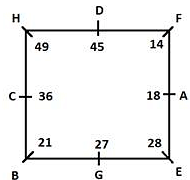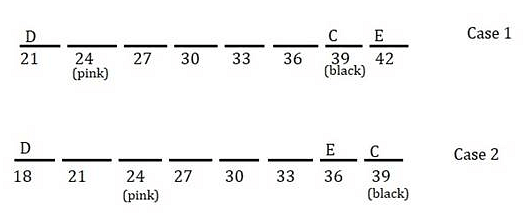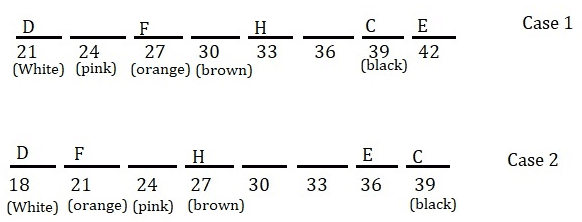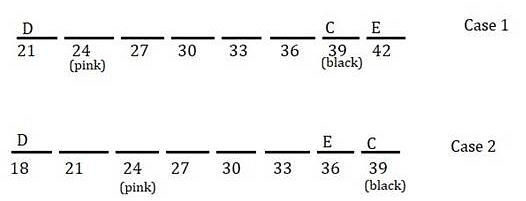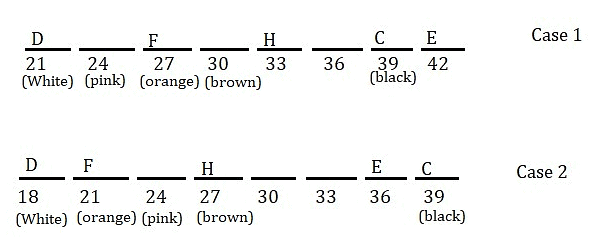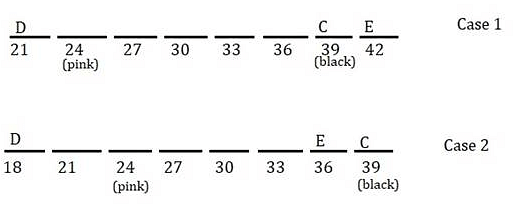MAH-CET MBA Mock Test- 5 - CAT MCQ
30 Questions MCQ Test - MAH-CET MBA Mock Test- 5
Kailash faces towards north. Turning to his right, he walks 25 m
etres. He then turns to his left and walks 35 metres. Next, he moves 25 metres to his right. He then turns to his right again and walks 55 metres. Finally, he turns to the right and moves 40 metres. In which direction is he from his starting point?
In each of the questions below are given four statements followed by four conclusions numbered I, II, III and IV. You have to take the given statements to be true even if they seem to be at variance from commonly known facts.
Read all the conclusions and then decide which of the given conclusions logically follows from the given statements disregarding commonly known facts.
Statements:
All ducks are labs.
No lab is a four.
Some fours are pockets.
All pockets are legs.
Conclusions:
I. All ducks being legs is a possibility.
II. Some pockets are ducks.
III. Some labs are ducks.
IV. No pocket is a duck.
| 1 Crore+ students have signed up on EduRev. Have you? Download the App |
Direction: In the following question three statements are given and these statements are followed by two conclusions numbered I and II. You have to take the given statements to be true even if they seem to be at variance from commonly known facts. Read the conclusions and then decide which of the given conclusions logically follows from the given statements.
Statements:
Some whistles are mice.
Some mice are lions.
Some lions are caves
Conclusions:
I. Some caves are mice.
II. All whistles are caves.
Five children sat for an aptitude test. In the result report, it was noted that child A scored less marks than child B. Child C scored less marks than child D . Child B scored less marks than child C and child A scored more marks than child E.
If the children are arranged in ascending order as per their marks then which child will be second from the left?
In each of the questions below are given four statements followed by four conclusions numbered I, II, III and IV. You have to take the given statements to be true even if they seem to be at variance from commonly known facts.
Read all the conclusions and then decide which of the given conclusions logically follows from the given statements disregarding commonly known facts.
Statements:
All flowers are jacks.
All jacks are jars.
Some jars are spurs.
All spurs are twos.
Conclusions:
I. Some spurs are jacks.
II. Some spurs are flowers.
III. At least some twos are jars.
IV. Some twos being flowers is a possibility.
Direction: Study the following information carefully and answer the question given below.
8 friends-P, Q, R, S, T, U, V, and W have taken floors on rent in a building that has 4 floors (1-4). Consider as 1st floor is the ground floor. Each floor is occupied with at least one person and not more than three persons. No two consecutive floors have the same number of occupants. The number of people staying on the odd number of floors is an odd number but the number of people on both the floors is different numbers. The number of people living on the floor of R is the same as that of S. S lives on a floor higher compared to R. P lives on a floor higher compared to W but a lower floor compared to T. P doesn’t live on an even-numbered floor. U doesn’t live on the same floor with R also not with P. V lives on a floor higher compared to U. Q and U do not live on the same floor.
Who among the following lives just below W’s floor?
Direction: Study the following information carefully and answer the question given below.
8 friends-P, Q, R, S, T, U, V, and W have taken floors on rent in a building that has 4 floors (1-4). Consider as 1st floor is the ground floor. Each floor is occupied with at least one person and not more than three persons. No two consecutive floors have the same number of occupants. The number of people staying on the odd number of floors is an odd number but the number of people on both the floors is different numbers. The number of people living on the floor of R is the same as that of S. S lives on a floor higher compared to R. P lives on a floor higher compared to W but a lower floor compared to T. P doesn’t live on an even-numbered floor. U doesn’t live on the same floor with R also not with P. V lives on a floor higher compared to U. Q and U do not live on the same floor.
Which of the following group live together?
Direction: Study the following information carefully and answer the question given below.
8 friends-P, Q, R, S, T, U, V, and W have taken floors on rent in a building that has 4 floors (1-4). Consider as 1st floor is the ground floor. Each floor is occupied with at least one person and not more than three persons. No two consecutive floors have the same number of occupants. The number of people staying on the odd number of floors is an odd number but the number of people on both the floors is different numbers. The number of people living on the floor of R is the same as that of S. S lives on a floor higher compared to R. P lives on a floor higher compared to W but a lower floor compared to T. P doesn’t live on an even-numbered floor. U doesn’t live on the same floor with R also not with P. V lives on a floor higher compared to U. Q and U do not live on the same floor.
Which of the following is living alone?
Direction: Study the following information carefully and answer the question given below.
8 friends-P, Q, R, S, T, U, V, and W have taken floors on rent in a building that has 4 floors (1-4). Consider as 1st floor is the ground floor. Each floor is occupied with at least one person and not more than three persons. No two consecutive floors have the same number of occupants. The number of people staying on the odd number of floors is an odd number but the number of people on both the floors is different numbers. The number of people living on the floor of R is the same as that of S. S lives on a floor higher compared to R. P lives on a floor higher compared to W but a lower floor compared to T. P doesn’t live on an even-numbered floor. U doesn’t live on the same floor with R also not with P. V lives on a floor higher compared to U. Q and U do not live on the same floor.
Who among the following lives with R?
Direction: Study the following information carefully and answer the question given below.
8 friends-P, Q, R, S, T, U, V, and W have taken floors on rent in a building that has 4 floors (1-4). Consider as 1st floor is the ground floor. Each floor is occupied with at least one person and not more than three persons. No two consecutive floors have the same number of occupants. The number of people staying on the odd number of floors is an odd number but the number of people on both the floors is different numbers. The number of people living on the floor of R is the same as that of S. S lives on a floor higher compared to R. P lives on a floor higher compared to W but a lower floor compared to T. P doesn’t live on an even-numbered floor. U doesn’t live on the same floor with R also not with P. V lives on a floor higher compared to U. Q and U do not live on the same floor.
How many persons live on the 3rd floor?
If all the letters of the word 'WATERING' are arranged in alphabetical order from left to right, then which of the following letter will be the fourth element from the right end?
Directions [Set of 5 questions]: A word and number arrangement machine when given an input line of words and numbers rearranges them following a particular rule in each step. The following is an illustration of the input and various steps of rearrangement.
INPUT: 56 papaya 91 kiwi 33 soya apple 42 16 mango
Step I: 16 56 papaya 91 kiwi 33 soya apple 42 mango
Step II:16 56 papaya 91 kiwi 33 soya 42 mango apple
Step III:16 42 56 papaya 91 kiwi 33soya mango apple
Step IV: 16 42 56 papaya 91 33 soya mango apple kiwi
Step V: 16 42 56 33 papaya 91 soya mango apple kiwi
Step VI: 16 42 56 33 papaya 91 soya apple kiwi mango
Step VII: 16 42 56 33 91 papaya soya apple kiwi mango
Step VIII: 16 42 56 33 91 soya apple kiwi mango papaya
Step IX: 16 42 56 33 91 apple kiwi mango papaya soya
As per the rules followed in above steps, answer the questions for the following input:
INPUT: Gold 88 silver bronze 34 53 iron 17 lead 68 31 nickel
How many total steps are there for the given input?
Directions [Set of 5 questions]: A word and number arrangement machine when given an input line of words and numbers rearranges them following a particular rule in each step. The following is an illustration of the input and various steps of rearrangement.
INPUT: 56 papaya 91 kiwi 33 soya apple 42 16 mango
Step I: 16 56 papaya 91 kiwi 33 soya apple 42 mango
Step II:16 56 papaya 91 kiwi 33 soya 42 mango apple
Step III:16 42 56 papaya 91 kiwi 33soya mango apple
Step IV: 16 42 56 papaya 91 33 soya mango apple kiwi
Step V: 16 42 56 33 papaya 91 soya mango apple kiwi
Step VI: 16 42 56 33 papaya 91 soya apple kiwi mango
Step VII: 16 42 56 33 91 papaya soya apple kiwi mango
Step VIII: 16 42 56 33 91 soya apple kiwi mango papaya
Step IX: 16 42 56 33 91 apple kiwi mango papaya soya
As per the rules followed in above steps, answer the questions for the following input:
INPUT: Gold 88 silver bronze 34 53 iron 17 lead 68 31 nickel
"34 68 88 17 31 53 silver bronze Gold iron lead nickel" is which step?
Directions [Set of 5 questions]: A word and number arrangement machine when given an input line of words and numbers rearranges them following a particular rule in each step. The following is an illustration of the input and various steps of rearrangement.
INPUT: 56 papaya 91 kiwi 33 soya apple 42 16 mango
Step I: 16 56 papaya 91 kiwi 33 soya apple 42 mango
Step II:16 56 papaya 91 kiwi 33 soya 42 mango apple
Step III:16 42 56 papaya 91 kiwi 33soya mango apple
Step IV: 16 42 56 papaya 91 33 soya mango apple kiwi
Step V: 16 42 56 33 papaya 91 soya mango apple kiwi
Step VI: 16 42 56 33 papaya 91 soya apple kiwi mango
Step VII: 16 42 56 33 91 papaya soya apple kiwi mango
Step VIII: 16 42 56 33 91 soya apple kiwi mango papaya
Step IX: 16 42 56 33 91 apple kiwi mango papaya soya
As per the rules followed in above steps, answer the questions for the following input:
INPUT: Gold 88 silver bronze 34 53 iron 17 lead 68 31 nickel
In which step does "53 lead 31" appears in the same order?
Directions [Set of 5 questions]: A word and number arrangement machine when given an input line of words and numbers rearranges them following a particular rule in each step. The following is an illustration of the input and various steps of rearrangement.
INPUT: 56 papaya 91 kiwi 33 soya apple 42 16 mango
Step I: 16 56 papaya 91 kiwi 33 soya apple 42 mango
Step II:16 56 papaya 91 kiwi 33 soya 42 mango apple
Step III:16 42 56 papaya 91 kiwi 33soya mango apple
Step IV: 16 42 56 papaya 91 33 soya mango apple kiwi
Step V: 16 42 56 33 papaya 91 soya mango apple kiwi
Step VI: 16 42 56 33 papaya 91 soya apple kiwi mango
Step VII: 16 42 56 33 91 papaya soya apple kiwi mango
Step VIII: 16 42 56 33 91 soya apple kiwi mango papaya
Step IX: 16 42 56 33 91 apple kiwi mango papaya soya
As per the rules followed in above steps, answer the questions for the following input:
INPUT: Gold 88 silver bronze 34 53 iron 17 lead 68 31 nickel
What is to the immediate left of 31 in step VII?
Directions [Set of 5 questions]: A word and number arrangement machine when given an input line of words and numbers rearranges them following a particular rule in each step. The following is an illustration of the input and various steps of rearrangement.
INPUT: 56 papaya 91 kiwi 33 soya apple 42 16 mango
Step I: 16 56 papaya 91 kiwi 33 soya apple 42 mango
Step II:16 56 papaya 91 kiwi 33 soya 42 mango apple
Step III:16 42 56 papaya 91 kiwi 33soya mango apple
Step IV: 16 42 56 papaya 91 33 soya mango apple kiwi
Step V: 16 42 56 33 papaya 91 soya mango apple kiwi
Step VI: 16 42 56 33 papaya 91 soya apple kiwi mango
Step VII: 16 42 56 33 91 papaya soya apple kiwi mango
Step VIII: 16 42 56 33 91 soya apple kiwi mango papaya
Step IX: 16 42 56 33 91 apple kiwi mango papaya soya
As per the rules followed in above steps, answer the questions for the following input:
INPUT: Gold 88 silver bronze 34 53 iron 17 lead 68 31 nickel
What is the eighth step for the given input?
In each of the questions below, two statements are given. From the options, choose the one that best depicts the relationship between the two statements.
I. For the past one week, the number of traffic accidents in neighbourhood T have increased.
II. A lot of pickpockets have been arrested in neighbourhood T in the past few months.
Each of the question below consists of a question and two or three statements numbered I, II and III given below it. You have to decide whether the data provided in the statements is sufficient to answer the question:
Twelve friends are sitting in two rows facing each other in such a way that P, Q, R, S, T and U sit facing south while A, B, C, D, E and F sit facing north. Then who sits facing Q?
I. R sits second to the right of S, who sits third to the left of P. D sits third to the right of E, who sits second to the left of B. T sits immediate right of U, who sits facing F, and C sits second to the left of A, who sits immediate right of E, and F sits at one end of the row.
II. B sits third to the right of C, who sits facing P, and S sits second to the left of R, who sits third to the right of T. D sits immediate right of B, who sits second to the right of E, and F sits immediate right of D, who sits facing T.
Directions [Set of 2 questions]: Read the following passages/statements and answer the questions that follow them.
Statement: Reliance Industries Ltd (RIL) wants its consumer businesses - Reliance Jio Infocomm Ltd and Reliance Retail Ltd - to contribute at par with its energy and materials businesses over the next decade, RIL chairman and managing director Mukesh Ambani said in his letter to shareholders.
Which of the following can be a possible reason(s) why RIL wants its consumer business to contribute at par with its energy and material businesses?
1. RIL's energy and material businesses have contributed towards building the brand image, which helped popularise products from other RIL's business segments.
2. RIL's consumer businesses have not attained a threshold from which they will start contributing meaningfully to consolidated profits.
3. Reliance Jio has 186.6 million customers.
Directions [Set of 2 questions]: Read the following passages/statements and answer the questions that follow them.
Statement: Reliance Industries Ltd (RIL) wants its consumer businesses - Reliance Jio Infocomm Ltd and Reliance Retail Ltd - to contribute at par with its energy and materials businesses over the next decade, RIL chairman and managing director Mukesh Ambani said in his letter to shareholders.
Which of the following can be inferred from the given statement?
1. Reliance Jio is currently making losses owing to its aggressive pricing strategy for market capitalisation.
2. The energy and materials counterpart of Reliance Industries Ltd (RIL) is doing better than Reliance Retail Ltd in terms of revenue.
3. The target set for Reliance Jio Infocomm Ltd and Reliance Retail Ltd to come at par with their energy and materials counterpart is set at 20 years from now.
Two statements numbered I and II given below. You have to decide whether the data provided in the statements are sufficient to answer the question.
What is the code for "Mini Ben" & 'Rony Ravi'?
Statement I: In certain code language 'po ko go co oo' means 'Riti Rita Reena Ravi Shiva', 'fo co bo vo po' means 'Riti Kirti Ravi Ravish Rony', 'io uo co vo oo' means 'Ravi Shiva Rony Mini Ben' and 'fo bo yo ro go' means 'Kirti Ravish Reena Shivani Sam'.
Statement II: In certain code language 'io uo co go po' means 'Riti Reena Ravi Mini Ben', 'xo to uo io fo' means 'Kirti Shivi Monu Mini Ben', 'ro vo bo io uo' means 'Sam Rony Ravish Ben Mini' and 'xo co io to uo' means 'Shivi Ravi Mini Monu Ben'.
Directions [Set of 5 questions]: Eight persons A, B, C, D, E, F, G and H were seated around a square table facing the centre. There was one person at each corner and one person along every side. Each person chose a different number which was a multiple of either 7 or 9. The numbers were neither less than 10 nor greater than 50. The persons seated at the corners chose multiples of 7 and the persons seated along the side chose the multiples of 9.
The one who chose 49 was third to the left of G. G and E chose consecutive numbers. E chose a number greater than that chosen by G. E was 2nd to the right of B. B was seated opposite to F. C chose a number that was twice as that of the number chosen by A. A was 3rd to the left of H. The difference between the numbers chosen by C and E was 8. The person who chose 14 was to the immediate right of A. The one who chose 45 was 3rd to the left of the one who chose 21.
Which of the following numbers was chosen by D?
Directions [Set of 5 questions]: Eight persons A, B, C, D, E, F, G and H were seated around a square table facing the centre. There was one person at each corner and one person along every side. Each person chose a different number which was a multiple of either 7 or 9. The numbers were neither less than 10 nor greater than 50. The persons seated at the corners chose multiples of 7 and the persons seated along the side chose the multiples of 9.
The one who chose 49 was third to the left of G. G and E chose consecutive numbers. E chose a number greater than that chosen by G. E was 2nd to the right of B. B was seated opposite to F. C chose a number that was twice as that of the number chosen by A. A was 3rd to the left of H. The difference between the numbers chosen by C and E was 8. The person who chose 14 was to the immediate right of A. The one who chose 45 was 3rd to the left of the one who chose 21.
How many persons chose a number lesser than that chosen by the one seated opposite to C?
Directions [Set of 5 questions]: Eight persons A, B, C, D, E, F, G and H were seated around a square table facing the centre. There was one person at each corner and one person along every side. Each person chose a different number which was a multiple of either 7 or 9. The numbers were neither less than 10 nor greater than 50. The persons seated at the corners chose multiples of 7 and the persons seated along the side chose the multiples of 9.
The one who chose 49 was third to the left of G. G and E chose consecutive numbers. E chose a number greater than that chosen by G. E was 2nd to the right of B. B was seated opposite to F. C chose a number that was twice as that of the number chosen by A. A was 3rd to the left of H. The difference between the numbers chosen by C and E was 8. The person who chose 14 was to the immediate right of A. The one who chose 45 was 3rd to the left of the one who chose 21.
Four of the following bear a similar relationship and hence form a group, who among the following is not a part of that group?
Directions [Set of 5 questions]: Eight persons A, B, C, D, E, F, G and H were seated around a square table facing the centre. There was one person at each corner and one person along every side. Each person chose a different number which was a multiple of either 7 or 9. The numbers were neither less than 10 nor greater than 50. The persons seated at the corners chose multiples of 7 and the persons seated along the side chose the multiples of 9.
The one who chose 49 was third to the left of G. G and E chose consecutive numbers. E chose a number greater than that chosen by G. E was 2nd to the right of B. B was seated opposite to F. C chose a number that was twice as that of the number chosen by A. A was 3rd to the left of H. The difference between the numbers chosen by C and E was 8. The person who chose 14 was to the immediate right of A. The one who chose 45 was 3rd to the left of the one who chose 21.
What was the position of A with respect to E?
Directions [Set of 5 questions]: Eight persons A, B, C, D, E, F, G and H were seated around a square table facing the centre. There was one person at each corner and one person along every side. Each person chose a different number which was a multiple of either 7 or 9. The numbers were neither less than 10 nor greater than 50. The persons seated at the corners chose multiples of 7 and the persons seated along the side chose the multiples of 9.
The one who chose 49 was third to the left of G. G and E chose consecutive numbers. E chose a number greater than that chosen by G. E was 2nd to the right of B. B was seated opposite to F. C chose a number that was twice as that of the number chosen by A. A was 3rd to the left of H. The difference between the numbers chosen by C and E was 8. The person who chose 14 was to the immediate right of A. The one who chose 45 was 3rd to the left of the one who chose 21.
Who among the following chose the 3rd highest number?
Anorexia Nervosa is an eating disorder defined as severe, self- inflicted starvation leading to body weight at least 15% below that expected for the individual's sex and height and age. Normally, medical treatment cannot be administered without the consent of the patient. However, mentally ill patients may not have the mental capacity to make a choice. Despite this, medical ethics, pragmatics and human rights call the treatment into question. Life is more important than dignity, many medical treatments are unpleasant or painful but they are necessary to preserve life. Without force feeding the anorectic patient will often die. Treatment for the psychological problem should be considered to go hand in hand with saving the patient's life.
It can be inferred from the passage that the author is least likely to agree with which of the following statements?
Directions [Set of 5 questions]: Study the following information carefully and answer the questions given below:
Eight persons A, B, C, D, E, F, G and H are having different ages. Their ages are consecutive multiple of 3 but not necessarily in the same order. They like different colors i.e. Yellow, Brown, White, Black, Red, Pink, Orange and Blue, not necessarily in the same order. C is 39 years old and likes Black color. D's age is half the age of E's age. The one who likes Pink is 24 years old. The one who likes Brown is 9 years elder to D. F likes Orange and younger to the one who likes Brown. H is 6 years elder to F. The one who likes White is younger to F. E is elder to G who likes Yellow. A is 30 years old and elder to H. The one who likes Red is younger to G.
Who among the following likes Brown?
Directions [Set of 5 questions]: Study the following information carefully and answer the questions given below:
Eight persons A, B, C, D, E, F, G and H are having different ages. Their ages are consecutive multiple of 3 but not necessarily in the same order. They like different colors i.e. Yellow, Brown, White, Black, Red, Pink, Orange and Blue, not necessarily in the same order. C is 39 years old and likes Black color. D's age is half the age of E's age. The one who likes Pink is 24 years old. The one who likes Brown is 9 years elder to D. F likes Orange and younger to the one who likes Brown. H is 6 years elder to F. The one who likes White is younger to F. E is elder to G who likes Yellow. A is 30 years old and elder to H. The one who likes Red is younger to G.
D likes which of the following color?
Directions [Set of 5 questions]: Study the following information carefully and answer the questions given below:
Eight persons A, B, C, D, E, F, G and H are having different ages. Their ages are consecutive multiple of 3 but not necessarily in the same order. They like different colors i.e. Yellow, Brown, White, Black, Red, Pink, Orange and Blue, not necessarily in the same order. C is 39 years old and likes Black color. D's age is half the age of E's age. The one who likes Pink is 24 years old. The one who likes Brown is 9 years elder to D. F likes Orange and younger to the one who likes Brown. H is 6 years elder to F. The one who likes White is younger to F. E is elder to G who likes Yellow. A is 30 years old and elder to H. The one who likes Red is younger to G.
Who among the following is not elder to A?


